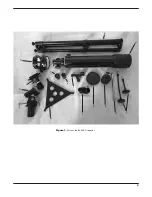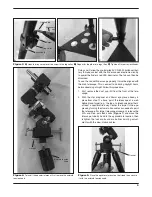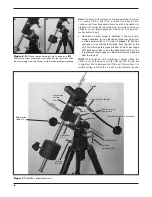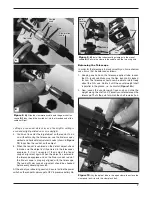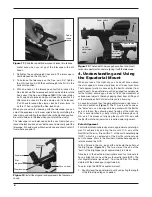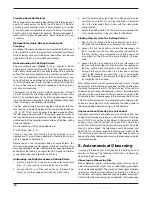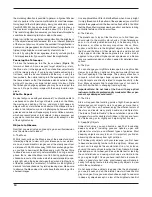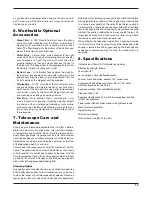
11
through the telescope. Avoid viewing over rooftops and chimneys,
as they often have warm air currents rising from them. Similarly,
avoid observing from indoors through an open (or closed) win-
dow, because the temperature difference between the indoor
and outdoor air will cause image blurring and distortion.
If at all possible, escape the light-polluted city sky and head for
darker country skies. You’ll be amazed at how many more stars
and deep-sky objects are visible in a dark sky!
“Seeing” and Transparency
Atmospheric conditions vary significantly from night to night.
“Seeing” refers to the steadiness of the Earth’s atmosphere at
a given time. In conditions of poor seeing, atmospheric turbu-
lence causes objects viewed through the telescope to “boil.”
If you look up at the sky and stars are twinkling noticeably,
the seeing is poor and you will be limited to viewing at lower
magnifications. At higher magnifications, images will not focus
clearly. Fine details on the planets and Moon will likely not be
visible.
In conditions of good seeing, star twinkling is minimal and
images appear steady in the eyepiece. Seeing is best over-
head, worst at the horizon. Also, seeing generally gets better
after midnight, when much of the heat absorbed by the Earth
during the day has radiated off into space.
Especially important for observing faint objects is good “trans-
parency”—air free of moisture, smoke, and dust. All tend to scat-
ter light, which reduces an object’s brightness. Transparency is
judged by the magnitude of the faintest stars you can see with
the unaided eye (5th or 6th magnitude is desirable).
Star-Testing the Telescope
When it is dark, point the telescope at a bright star and accu-
rately center it in the eyepiece’s field of view. Slowly de-focus the
image with the focus knob. If the telescope’s optics are correctly
aligned, the expanding disk should be a perfect circle
(Figure
16). If the image is unsymmetrical, the optics are out of align-
ment. The dark shadow cast by the secondary mirror should
appear in the very center of the out-of-focus circle, like the hole
in a donut. If the “hole” appears off-center, the optics are out of
alignment.
If you try the star test and the bright star you have selected
is not accurately centered in the eyepiece, the telescope will
appear to need collimating, even though the optics may be
perfectly aligned. It is critical to keep the star centered, so over
time you will need to make slight corrections to the telescope’s
position in order to account for the sky’s apparent motion.
given time. In conditions of poor seeing, atmospheric turbulence
causes objects viewed through the telescope to “boil.” If you look
up at the sky and stars are twinkling noticeably, the seeing is
poor and you will be limited to viewing at lower magnifications. At
higher magnifications, images will not focus clearly. Fine details
on the planets and Moon will likely not be visible.
In conditions of good seeing, star twinkling is minimal and
images appear steady in the eyepiece. Seeing is best overhead,
worst at the horizon. Also, seeing generally gets better after mid-
night, when much of the heat absorbed by the Earth during the
day has radiated off into space.
Especially important for observing faint objects is good “trans-
parency”—air free of moisture, smoke, and dust. All tend to scat-
ter light, which reduces an object’s brightness. Transparency is
judged by the magnitude of the faintest stars you can see with
the unaided eye (5th or 6th magnitude is desirable).
Cooling the Telescope
All optical instruments need time to reach “thermal equilibri-
um.” The bigger the instrument and the larger the temperature
change, the more time is needed. Allow at least 30 minutes for
your telescope to acclimate to the temperature outdoors before
you start observing with it.
Let Your Eyes Dark-Adapt
Don’t expect to go from a lighted house into the darkness of the
outdoors at night and immediately see faint nebulas, galaxies,
and star clusters—or even very many stars, for that matter. Your
eyes take about 30 minutes to reach perhaps 80% of their full
dark-adapted sensitivity. As your eyes become dark-adapted,
more stars will glimmer into view and you’ll be able to see fainter
details in objects you view in your telescope.
To see what you’re doing in the darkness, use a red-filtered flash-
light rather than a white light. Red light does not spoil your eyes’
dark adaptation like white light does. A flashlight with a red LED
light is ideal. Beware, too, that nearby porch, streetlights, and car
headlights will ruin your night vision.
Eyepiece Selection
Magnification, or power, is determined by the focal length of
the telescope and the focal length of the eyepiece being used.
Therefore, by using eyepieces of different focal lengths, the
resultant magnification can be varied. It is quite common for
an observer to own five or more eyepieces to access a wide
range of magnifications. This allows the observer to choose the
best eyepiece to use depending on the object being viewed
and viewing conditions. Your BX90’s EQ refractor comes with
25mm and 10mm eyepieces, which will suffice nicely to begin
with. You can purchase additional eyepieces later if you wish to
have more magnification options.
Magnification is calculated as follows:
Telescope Focal Length (mm)
= Magnification
Eyepiece Focal Length (mm)
For example, the BX90 EQ has a focal length of 600mm, which
when used with the supplied 25mm eyepiece yields:
600 mm
= 24x
25 mm
The magnification provided by the 10mm eyepiece is:
600 mm
= 60x
10 mm
The maximum attainable magnification for a telescope is directly
related to how much light it can gather. The larger the aperture,
Summary of Contents for 52588
Page 3: ...3 Figure 1 Parts of the BX90 EQ refractor A H I J F G C D B L K M E...
Page 14: ...14...
Page 15: ...15...



